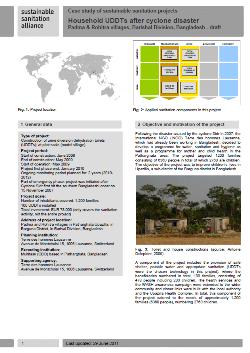Household UDDTs after cyclone disaster, Padma and Rohitra villages, Barishal Division, Bangladesh - Case study of sustainable sanitation projects
Delepière, A. (2011)

Published in: 2011
Publisher:
Sustainable Sanitation Alliance (SuSanA)
Author:
Delepière, A.
Uploaded by:
SuSanA secretariat
Partner profile:
common upload
12311 Views
205 Downloads
Location of library entry
Content - Summary
On 15 November 2007, the first storms of what was to become cyclone Sidr hit the southern coastline of Bangladesh. The force destroyed approximately 750,000 homes, tore up trees, damaged or destroyed roads, community centres, clinics and schools and brought down power and communication lines.
In response to cyclone Sidr, the International NGO (INGO) Terre des hommes Lausanne, which had already been working in Bangladesh, decided to develop and implement a post-rehabilitation project in Barguna District (Barisal Division). The project took place between June 2008 and May 2009 with the main focus being on housing, sanitation and water management systems, and primary health care in particular mother and child health.
In total, 100 families, consisting of 478 people including 233 children, received safe shelter (new houses were built), potable water and appropriate sanitation (UDDTs were the chosen technology in this project). The health services were extended to the wider community and closer links were built with the local authority and the Upazilla Health Complex.
The constructed UDDTs' robustness was put to the test when on 27 May 2009 Cyclone Aila hit Southern Bangladesh. Alia was categorised as a category 1 cyclone with wind speeds ranging between 74 and 120 km/h. The UDDTs withstood both the winds and the associated flooding that followed the cyclone. Pictures taken shortly after Cyclone Aila are included in the case study.
Bibliographic information
Delepière, A. (2011). Household UDDTs after cyclone disaster, Padma and Rohitra villages, Barishal Division, Bangladesh - Case study of sustainable sanitation projects. Sustainable Sanitation Alliance (SuSanA)
Filter tags
Case studies in SuSanA template East Asia & Pacific English Rural Urine diversion dehydration toilets (UDDTs)















